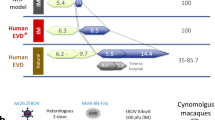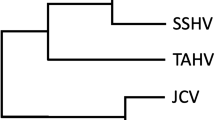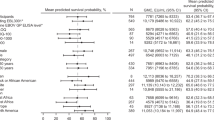Abstract
SEVERAL investigators have assayed sera of non-human primates for antibody to the Epstein–Barr virus (EBV). Gerber and Birch1 reported the widespread distribution of complement-fixing antibody derived from the chimpanzee, baboon, rhesus and African green monkey. In a subsequent study, Gerber and Rosenblum2 reported that many rhesus monkeys bled within 4 days of capture were also EBV seropositive, but Henle and Henle3 had previously failed to demonstrate EBV antibody using the indirect immunofluorescence method in sera from the chimpanzee, baboon and rhesus monkey. Two of 4 baboons, however, inoculated in our laboratory with 108 EB3 cells were found by the Henles3 to have low levels of antibody 4–8 weeks after exposure. Landon and Malan4 have reported the presence of EBV antibody in rhesus and cynomolgus monkeys at birth. This antibody disappeared after 8–10 months, although sera from the mothers of these animals remained positive. Levy et al.5 were able to demonstrate antibody in 2 of 3 chimpanzees bled immediately after capture in the jungle. The number of animals used, species and geographic distribution, and finally the lack of history on the animals involved in all of these studies, plus the need for a suitable experimental host system, suggested that additional studies were worth pursuing.
This is a preview of subscription content, access via your institution
Access options
Subscribe to this journal
Receive 51 print issues and online access
$199.00 per year
only $3.90 per issue
Buy this article
- Purchase on Springer Link
- Instant access to full article PDF
Prices may be subject to local taxes which are calculated during checkout
Similar content being viewed by others
References
Gerber, P., and Birch, S. M., Proc. US Nat. Acad. Sci., 58, 478 (1967).
Gerber, P., and Rosenblum, E. N., Proc. Soc. Exp. Biol. Med., 128, 541 (1968).
Henle, G., and Henle, W., Cancer Res., 27, 2442 (1967).
Landon, J. C., and Malan, L. B., J. Nat. Cancer Inst., 46, 881 (1971).
Levy, J. A., Levy, S. B., Hirshaut, Y., Kafuko, G., and Prince, A., Nature, 233, 559 (1971).
Henle, G., and Henle, W., J. Bacteriol., 91, 1248 (1966).
Kalter, S. S., and Heberling, R. L., Bacteriol. Rev., 35, 310 (1971).
Author information
Authors and Affiliations
Rights and permissions
About this article
Cite this article
KALTER, S., HEBERLING, R. & RATNER, J. EBV Antibody in Sera of Non-human Primates. Nature 238, 353–354 (1972). https://doi.org/10.1038/238353a0
Received:
Issue Date:
DOI: https://doi.org/10.1038/238353a0
Comments
By submitting a comment you agree to abide by our Terms and Community Guidelines. If you find something abusive or that does not comply with our terms or guidelines please flag it as inappropriate.



